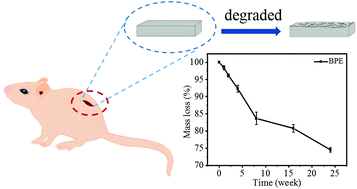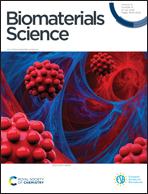Synthesis of bio-based polyester elastomers and evaluation of their in vivo biocompatibility and biodegradability as biomedical materials†
Abstract
Biodegradable polyester elastomers have found wide application in the tissue engineering field. In this study, an all bio-based polyester elastomer (BPE) is synthesized from five bio-based monomers; and the in vivo biodegradability and biocompatibility of the BPE are first evaluated using a subcutaneous mouse model, aiming to investigate its potential application as a soft tissue repair material. The biodegradation property of the BPE in the subcutaneous part of the back region of mice is systematically studied by monitoring the mass loss and the morphological change of the BPE over different times. It is found that the mass loss increases with increasing time, and the mass loss reaches more than 25% after implantation for 24 weeks. From the scanning electron microscope results, the BPE shows surface degradation behavior, which would be beneficial for maintaining their structural integrity until later stages of degradation and be suitable for biomedical application. Furthermore, after subcutaneous implantation of the BPE, the blood and urine routine indexes remain within normal ranges and histology of the major organs shows no abnormalities in H&E staining analysis, which indicates the excellent in vivo biocompatibility of the BPE.



 Please wait while we load your content...
Please wait while we load your content...